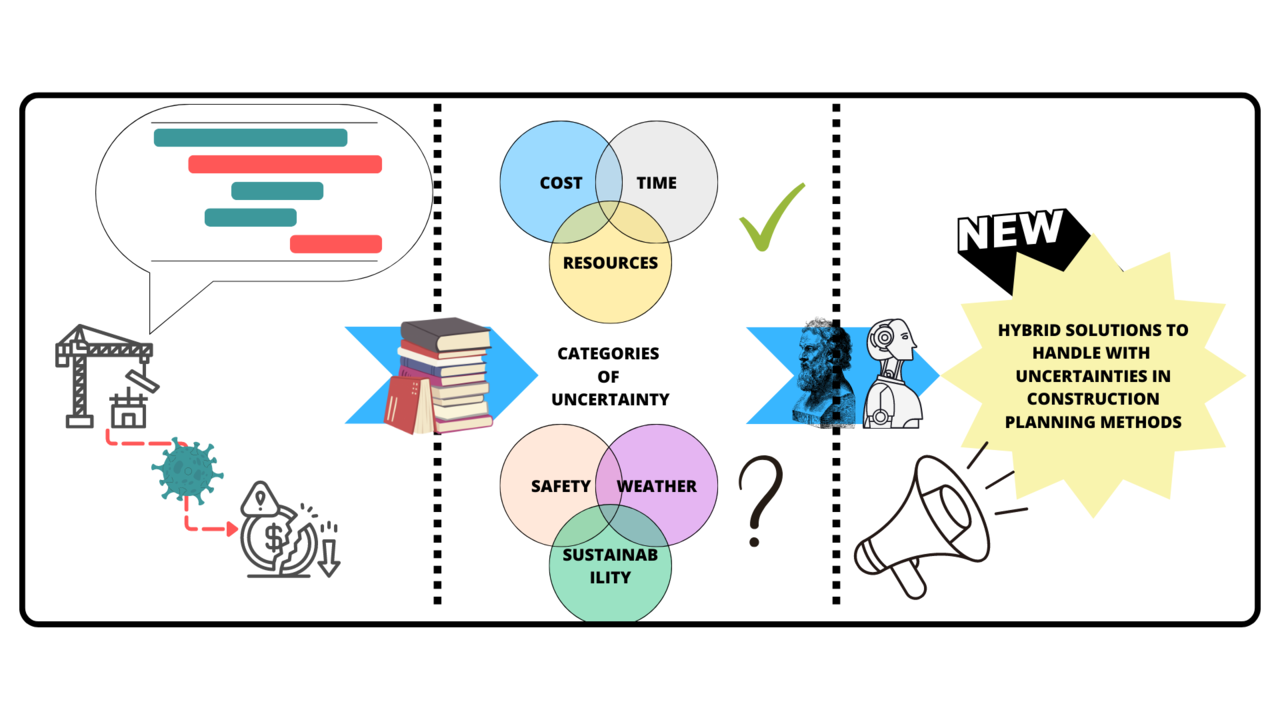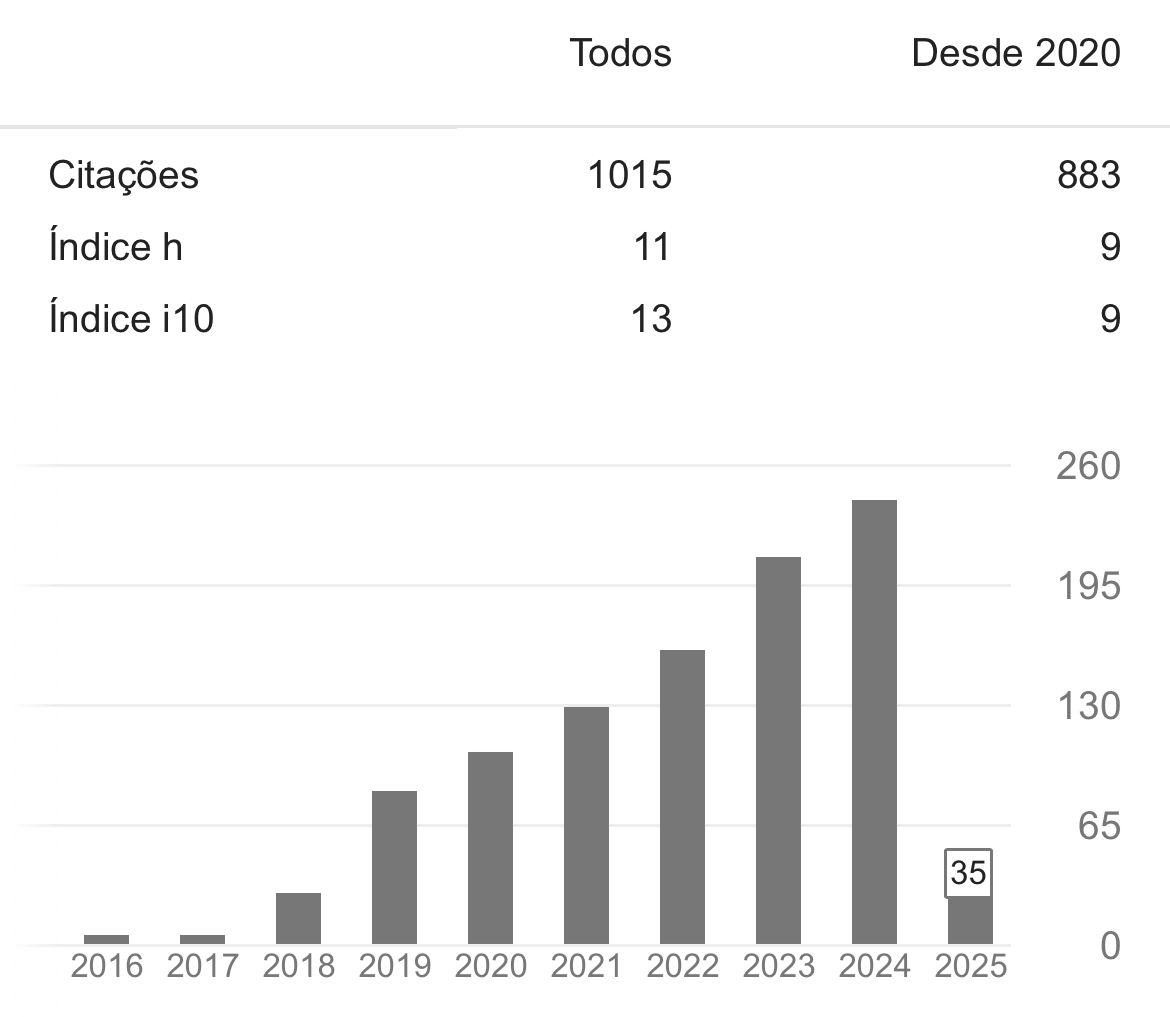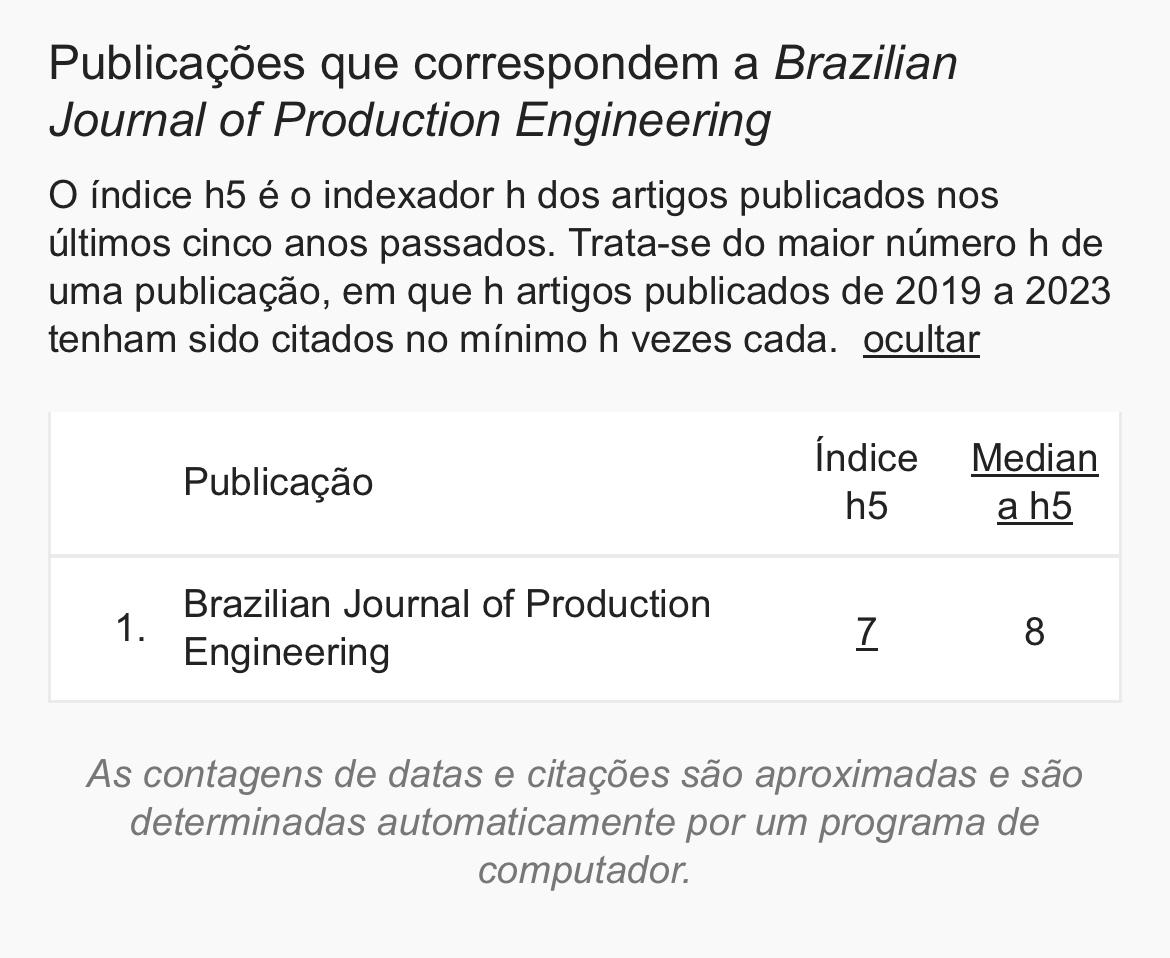Planejamento para o imprevisto em projetos de construção: uma revisão
DOI:
https://doi.org/10.47456/bjpe.v9i4.42244Keywords:
métodos de planejamento de obras, revisão sistemática da literatura, incertezas, eventos aleatóriosAbstract
Crises globais, como pandemias e guerras, evidenciam como os projetos de construção são afetados por eventos inesperados, normalmente ignorados pelas equipes de planejamento. Portanto, o objetivo deste estudo é revisar a literatura para entender como as incertezas são consideradas nos métodos de planejamento de obra e quais são as próximas etapas para enfrentar novas crises. Assim, os autores mapearam as variáveis tradicionais que são incluídas como incertezas nos métodos de planejamento, como tempo e custo do projeto, bem como as variáveis incomuns que não são normalmente incluídas como incertezas nos métodos, como questões de segurança e sustentabilidade. O estado da arte dos métodos de planejamento com incertezas envolveu uma leitura minuciosa de 103 artigos de periódicos encontrados por meio de uma revisão sistemática adaptada da literatura, que incluiu, além dos processos tradicionais, um estudo cienciométrico e uma análise de bola de neve. Como resultado, descobriu-se que as principais incertezas consideradas estão relacionadas a tempo, custo e recursos. Além disso, foi possível observar que não existe uma única técnica consolidada para incorporar incertezas nos métodos de planejamento, mas sim uma combinação de diferentes técnicas, desde as mais tradicionais com análise analítica até as mais contemporâneas com algoritmos de inteligência artificial.
Downloads
References
Abbasi, S., Taghizade, K., & Noorzai, E. (2020). BIM-Based Combination of Takt Time and Discrete Event Simulation for Implementing Just in Time in Construction Scheduling under Constraints. Journal of Construction Engineering and Management, 146(12).
https://doi.org/10.1061/(ASCE)CO.1943-7862.0001940 DOI: https://doi.org/10.1061/(ASCE)CO.1943-7862.0001940
AbouRizk, S. M. & Halpin, D. (1992). Statistical properties of construction duration data. Journal of the Construction Division and Management, 118(3), 525–544. https://doi.org/10.1061/(asce)0733-9364(1992)118:3(525 DOI: https://doi.org/10.1061/(ASCE)0733-9364(1992)118:3(525)
AbouRizk, S. M. & Sawhney, A. (1993). Subjective and interactive duration estimation. Canadian Journal of Civil Engineering, 20(3), 457–470.
https://doi.org/10.1139/l93-060 DOI: https://doi.org/10.1139/l93-060
Alhussein, H., Shehab, L., & Hamzeh, F. (2022). Improvisation in Construction Planning: An Agent-Based Simulation Approach. Buildings, 12(10):1608.
https://doi.org/10.3390/buildings12101608 DOI: https://doi.org/10.3390/buildings12101608
AlJassmi, H., Abduljalil, Y., & Philip, B. (2023). Towards Self-Recovering Construction Schedules: A New Method for Periodically Updating Project Plans and Optimizing Recovery Actions. Journal of Asian Architecture and Building Engineering, 22(4), 2335-2347.
https://doi.org/10.1080/13467581.2022.2153055 DOI: https://doi.org/10.1080/13467581.2022.2153055
Ansari, R. (2021). Dynamic Optimization for Analyzing Effects of Multiple Resource Failures on Project Schedule Robustness. KSCE Journal of Civil Engineering, 25(5), 1515-1532.
https://doi.org/10.1007/s12205-021-0564-1 DOI: https://doi.org/10.1007/s12205-021-0564-1
Bacon, R., Besant-Jones, J., & Heidarian, J. (1996). Estimating construction costs and schedules: Experience with power generation projects in developing countries. World Bank Technical Paper No. 325. World Bank Technical Paper. http://www.osti.gov/scitech/biblio/564865-estimating-construction-costs-schedules-experience-power-generation-projects-developing-countries-world-bank-technical-paper DOI: https://doi.org/10.1596/0-8213-3670-3
Benjaoran, V. & Bhokha, S. (2010). An integrated safety management with construction management using 4D CAD model. Safety Science, 48(3), 395–403.
https://doi.org/10.1016/j.ssci.2009.09.009 DOI: https://doi.org/10.1016/j.ssci.2009.09.009
Bi, L., Ren, B., Zhong, D., & Hu, L. (2015). Real-Time Construction Schedule Analysis of Long-Distance Diversion Tunnels Based on Lithological Predictions Using a Markov Process. Journal of Construction Engineering and Management, 141(2).
https://doi.org/10.1061/(ASCE)CO.1943-7862.0000935 DOI: https://doi.org/10.1061/(ASCE)CO.1943-7862.0000935
Boletim Estatístico da Construção Civil. (2023, October 16). CBIC. Retrieved October 17, 2023, from http://www.cbicdados.com.br/media/anexos/Boletim_Ano19n08_ago23.pdf
Bruni, M. E., Beraldi, P., Guerriero, F., & Pinto, E. (2011). A scheduling methodology for dealing with uncertainty in construction projects. Engineering Computations, 28(8), 1064–1078. https://doi.org/10.1108/02644401111179036 DOI: https://doi.org/10.1108/02644401111179036
Caron, F., Marchet, G., & Perego, A. (1998). Project logistics: integrating the procurement and construction processes. International Journal of Project Management, 16(5), 311–319. https://doi.org/10.1016/s0263-7863(97)00029-x DOI: https://doi.org/10.1016/S0263-7863(97)00029-X
Chakraborty, D., Elhegazy, H., Elzarka, H., & Gutierrez, L. (2020). A novel construction cost prediction model using hybrid natural and light gradient boosting. Advanced Engineering Informatics, 46, 101201.
https://doi.org/10.1016/j.aei.2020.101201 DOI: https://doi.org/10.1016/j.aei.2020.101201
Chen, L., Lu, Q., Li, S., He, W., & Yang, J. (2021). Bayesian Monte Carlo Simulation–Driven Approach for Construction Schedule Risk Inference. Journal of Management in Engineering, 37(2).
https://doi.org/10.1061/(ASCE)ME.1943-5479.0000884 DOI: https://doi.org/10.1061/(ASCE)ME.1943-5479.0000884
Chen, L., Lu, Q., & Han, D. (2023). A Bayesian-driven Monte Carlo Approach for Managing Construction Schedule Risks of Infrastructures under Uncertainty. Expert Systems with Applications, 212.
https://doi.org/10.1016/j.eswa.2022.118810 DOI: https://doi.org/10.1016/j.eswa.2022.118810
Cheng, M.-Y., Wu, Y.-W., Dan, L. T., & Van Roy, A. F. (2013). Enhanced Time-Dependent Evolutionary Fuzzy Support Vector Machines Inference Model for Cash Flow Prediction and Estimate at Completion. International Journal of Information Technology & Decision Making, 12(04), 679–710.
https://doi.org/10.1142/S0219622013500259 DOI: https://doi.org/10.1142/S0219622013500259
Clark, W. (1922). The Gantt Chart, a working tool of management.
Contas Nacionais Trimestrais: 2o Trimestre de 2023. (2023, September 1). IBGE. Retrieved October 17, 2023, from https://agenciadenoticias.ibge.gov.br/media/com_mediaibge/arquivos/982773d7ba3852e69fb969376436e9ea.pdf
De Meyer, A., Loch, C. H., & Pich, M. T. (2002). Managing project uncertainty: From variation to chaos. MIT Sloan Management Review, 43(2), 60–67. DOI: https://doi.org/10.1109/EMR.2002.1032403
Denyer, D., & Tranfield, D. (2009). Producing a systematic review. In The Sage handbook of organizational research methods. (671–689). Sage Publications Ltd.
Du, J., Kim, B. C., & Zhao, D. (2016). Cost performance as a stochastic Process: EAC projection by Markov Chain Simulation. Journal of the Construction Division and Management. https://doi.org/10.1061/(asce)co.1943-7862.0001115 DOI: https://doi.org/10.1061/(ASCE)CO.1943-7862.0001115
Edmund, B., Yang, H., & Asa, E. (2018). A General Overview of the Impact of Global Financial Crisis on Construction Industries. International Conference on Construction and Real Estate Management. https://doi.org/10.1061/9780784481745.004 DOI: https://doi.org/10.1061/9780784481745.004
Elhakeem, A. & Hegazy, T. (2005). Graphical approach for manpower planning in infrastructure networks. Journal of the Construction Division and Management, 131(2), 168–175. https://doi.org/10.1061/(asce)0733-9364(2005)131:2(168 DOI: https://doi.org/10.1061/(ASCE)0733-9364(2005)131:2(168)
Enshassi, A., Mohamed, S. A. M., & Abushaban, S. (2009). Factors affecting the performance of construction projects in the Gaza strip. Journal of Civil Engineering and Management, 15(3), 269–280.https://doi.org/10.3846/1392-3730.2009.15.269-280 DOI: https://doi.org/10.3846/1392-3730.2009.15.269-280
Feng, K., Lu, W., Olofsson, T., Chen, S., Yan, H., & Wang, Y. (2018). A Predictive Environmental Assessment Method for Construction Operations: Application to a Northeast China Case Study. Sustainability, 10(11), 3868.
https://doi.org/10.3390/su10113868 DOI: https://doi.org/10.3390/su10113868
Feng, K., Wang, S., Lu, W., Liu, C., & Wang, Y. (2022). Planning Construction Projects in Deep Uncertainty: A Data-Driven Uncertainty Analysis Approach. Journal of Construction Engineering and Management, 148(8).
https://doi.org/10.1061/(ASCE)CO.1943-7862.0002315 DOI: https://doi.org/10.1061/(ASCE)CO.1943-7862.0002315
Fitzsimmons, J. P., Lu, R., Hong, Y., & Brilakis, I. (2022). Construction schedule risk analysis – a hybrid machine learning approach. Journal of Information Technology in Construction, 27, 70–93.
https://doi.org/10.36680/j.itcon.2022.004 DOI: https://doi.org/10.36680/j.itcon.2022.004
Fondahl, J. W. (1962). A Non-Computer Approach to the Critical Path Method for the Construction Industry, Technical Report #9. Department of Civil Engineering, Stanford University, Stanford, CA.
Ford, D. N., Lander, D. M., & Voyer, J. J. (2002). A real options approach to valuing strategic flexibility in uncertain construction projects. Construction Management and Economics, 20(4), 343–351.
https://doi.org/10.1080/01446190210125572 DOI: https://doi.org/10.1080/01446190210125572
Francis, A. (2019). Chronographical spatiotemporal scheduling optimization for building projects. Frontiers in Built Environment, 5. https://doi.org/10.3389/fbuil.2019.00036 DOI: https://doi.org/10.3389/fbuil.2019.00036
Geissdoerfer, M., Savaget, P., Bocken, N., & Hultink, E. J. (2017). The Circular Economy – A new sustainability paradigm? Journal of Cleaner Production, 143, 757–768. https://doi.org/10.1016/j.jclepro.2016.12.048 DOI: https://doi.org/10.1016/j.jclepro.2016.12.048
Goh, Y. M. & Askar Ali, M. J. (2016). A hybrid simulation approach for integrating safety behavior into construction planning: An earthmoving case study. Accident Analysis & Prevention, 93, 310–318.
https://doi.org/10.1016/j.aap.2015.09.015 DOI: https://doi.org/10.1016/j.aap.2015.09.015
Hadipriono, F. C. (1988). Fault tree network analysis for construction. Civil Engineering Systems, 5(1), 42–48. https://doi.org/10.1080/02630258808970501 DOI: https://doi.org/10.1080/02630258808970501
Halpin, D. (1977). Cyclone–Method for modeling job site processes. Journal of the Construction Division, 103(3), 489–499. https://doi.org/10.1061/jcceaz.0000712 DOI: https://doi.org/10.1061/JCCEAZ.0000712
Hassan, A., El-Rayes, K., & Attalla, M. (2021). Stochastic scheduling optimization of repetitive construction projects to minimize project duration and cost. The International Journal of Construction Management, 1–10.
https://doi.org/10.1080/15623599.2021.1975078 DOI: https://doi.org/10.1080/15623599.2021.1975078
He, Q., Wang, G., Luo, L., Shi, Q., Xie, J., & Meng, X. (2017). Mapping the managerial areas of Building Information Modeling (BIM) using scientometric analysis. International Journal of Project Management, 35(4), 670–685.
https://doi.org/10.1016/j.ijproman.2016.08.001 DOI: https://doi.org/10.1016/j.ijproman.2016.08.001
Hosny, A., Nik-Bakht, M., & Moselhi, O. (2020). Workspace planning in construction: non-deterministic factors. Automation in Construction, 116, 103222.
https://doi.org/10.1016/j.autcon.2020.103222 DOI: https://doi.org/10.1016/j.autcon.2020.103222
Hosny, A., Nik-Bakht, M., & Moselhi, O. (2022). Physical Distancing Analytics for Construction Planning Using 4D BIM. Journal of Computing in Civil Engineering, 36(4).
https://doi.org/10.1061/(ASCE)CP.1943-5487.0001023 DOI: https://doi.org/10.1061/(ASCE)CP.1943-5487.0001023
Hossen, M. M., Kang, S., & Kim, J. (2015). Construction schedule delay risk assessment by using combined AHP-RII methodology for an international NPP project. Nuclear Engineering and Technology, 47(3), 362–379.
https://doi.org/10.1016/j.net.2014.12.019 DOI: https://doi.org/10.1016/j.net.2014.12.019
Hu, S., Fang, Y., & Moehler, R. (2023). Estimating and Visualizing the Exposure to Tower Crane Operation Hazards on Construction Sites. Safety Science, 160.
https://doi.org/10.1016/j.ssci.2022.106044 DOI: https://doi.org/10.1016/j.ssci.2022.106044
Isidore, R. J. L., Back, W. E., & Fry, G. T. (2001). Integrated probabilistic schedules and estimates from project simulated data. Construction Management and Economics, 19(4), 417–426. https://doi.org/10.1080/01446190010022677 DOI: https://doi.org/10.1080/01446190010022677
Jalali, S. & Wohlin, C. (2012). Systematic literature studies: Database Searches vs. Backward Snowballing. ESEM’12: International Conference on Empirical Software Engineering and Measurement. https://doi.org/10.1145/2372251.2372257 DOI: https://doi.org/10.1145/2372251.2372257
Jaśkowski, P. & Sobotka, A. (2006). Scheduling construction projects using evolutionary algorithm. Journal of the Construction Division and Management, 132(8), 861–870. https://doi.org/10.1061/(asce)0733-9364(2006)132:8(861 DOI: https://doi.org/10.1061/(ASCE)0733-9364(2006)132:8(861)
Kammouh, O., Nogal, M., Binnekamp, R., & Wolfert, A. R. M. (2022). Dynamic control for construction project scheduling on-the-run. Automation in Construction, 141, 104450.
https://doi.org/10.1016/j.autcon.2022.104450 DOI: https://doi.org/10.1016/j.autcon.2022.104450
Kavanagh, D. P. (1985). SIREN: A Repetitive Construction Simulation model. Journal of the Construction Division and Management, 111(3), 308–323. https://doi.org/10.1061/(asce)0733-9364(1985)111:3(308 DOI: https://doi.org/10.1061/(ASCE)0733-9364(1985)111:3(308)
Kedir, N. S., Somi, S., Fayek, A. R., & Nguyen, P. H. D. (2022). Hybridization of reinforcement learning and agent-based modeling to optimize construction planning and scheduling. Automation in Construction, 142, 104498.
https://doi.org/10.1016/j.autcon.2022.104498 DOI: https://doi.org/10.1016/j.autcon.2022.104498
Kelley, J. E., & Walker, M. R. (1959). Critical-path planning and scheduling. IRE-AIEE-ACM Computer Conference. https://doi.org/10.1145/1460299.1460318 DOI: https://doi.org/10.1145/1460299.1460318
Khan, K. S., Kunz, R., Kleijnen, J., & Antes, G. (2003). Five steps to conducting a systematic review. JRSM, 96(3), 118–121.
https://doi.org/10.1258/jrsm.96.3.118 DOI: https://doi.org/10.1258/jrsm.96.3.118
Kim, J.-L. & Ellis, R. D. (2009). Robust global and local search approach to resource-constrained project scheduling. Canadian Journal of Civil Engineering, 36(3), 375–388.
https://doi.org/10.1139/L08-135 DOI: https://doi.org/10.1139/L08-135
Kokkaew, N. & Chiara, N. (2010). Modelling completion risk using stochastic critical path‐envelope method: a BOT highway project application. Construction Management and Economics, 28(12), 1239–1254. https://doi.org/10.1080/01446193.2010.521755 DOI: https://doi.org/10.1080/01446193.2010.521755
Laufer, A. & Cohenca, D. (1990). Factors Affecting Construction‐Planning Outcomes. Journal of Construction Engineering and Management, 116(1), 135–156.
https://doi.org/10.1061/(ASCE)0733-9364(1990)116:1(135) DOI: https://doi.org/10.1061/(ASCE)0733-9364(1990)116:1(135)
Lee, D. (2005). Probability of project completion using stochastic project scheduling simulation. Journal of the Construction Division and Management, 131(3), 310–318. https://doi.org/10.1061/(asce)0733-9364(2005)131:3(310 DOI: https://doi.org/10.1061/(ASCE)0733-9364(2005)131:3(310)
Lee, H., Shin, J., Park, M., & Ryu, H.-G. (2009). Probabilistic Duration Estimation Model for High-Rise Structural Work. Journal of Construction Engineering and Management, 135(12), 1289–1298.
https://doi.org/10.1061/(ASCE)CO.1943-7862.0000105 DOI: https://doi.org/10.1061/(ASCE)CO.1943-7862.0000105
Lempert, R. J., Popper, S. W., & Bankes, S. C. (2003). Shaping the Next One Hundred Years: New Methods for Quantitative, Long-Term Policy Analysis. RAND Corporation.
https://doi.org/10.7249/MR1626 DOI: https://doi.org/10.7249/MR1626
Leu, S.-S., Chen, A.-T., & Yang, C.-H. (1999a). Fuzzy Optimal Model for Resource-Constrained Construction Scheduling. Journal of Computing in Civil Engineering, 13(3), 207–216.
https://doi.org/10.1061/(ASCE)0887-3801(1999)13:3(207) DOI: https://doi.org/10.1061/(ASCE)0887-3801(1999)13:3(207)
Leu, S.-S., Chen, A.-T., & Yang, C.-H. (1999b). A fuzzy optimal model for construction resource leveling scheduling. Canadian Journal of Civil Engineering, 26(6), 673–684.
https://doi.org/10.1139/l99-028 DOI: https://doi.org/10.1139/l99-028
Leu, S.-S., Chen, A.-T., & Yang, C.-H. (2001). A GA-based fuzzy optimal model for construction time–cost trade-off. International Journal of Project Management, 19(1), 47–58.
https://doi.org/10.1016/S0263-7863(99)00035-6 DOI: https://doi.org/10.1016/S0263-7863(99)00035-6
Leu, S.-S. & Hung, T.-H. (2002). A genetic algorithm-based optimal resource-constrained scheduling simulation model. Construction Management and Economics, 20(2), 131–141.
https://doi.org/10.1080/01446190110109148 DOI: https://doi.org/10.1080/01446190110109148
Li, H., Chan, N., Huang, T., Guo, H. L., Lu, W., & Skitmore, M. (2009). Optimizing construction planning schedules by virtual prototyping enabled resource analysis. Automation in Construction, 18(7), 912–918.
https://doi.org/10.1016/j.autcon.2009.04.002 DOI: https://doi.org/10.1016/j.autcon.2009.04.002
Li, Q., Tao, S., Chong, H.-Y., & Dong, Z. S. (2018). Robust Optimization for Integrated Construction Scheduling and Multiscale Resource Allocation. Complexity, 2018, 1–17.
https://doi.org/10.1155/2018/2697985 DOI: https://doi.org/10.1155/2018/2697985
Ma, G., Wang, A., Li, N., Gu, L., & Ai, Q. (2014). Improved Critical Chain Project Management Framework for Scheduling Construction Projects. Journal of Construction Engineering and Management, 140(12).
https://doi.org/10.1061/(ASCE)CO.1943-7862.0000908 DOI: https://doi.org/10.1061/(ASCE)CO.1943-7862.0000908
Malcolm, D. G., Roseboom, J. H., Clark, C. E., & Fazar, W. (1959). Application of a technique for research and development program evaluation. Operations Research, 7(5), 646–669. https://doi.org/10.1287/opre.7.5.646 DOI: https://doi.org/10.1287/opre.7.5.646
Manik, A., Gopalakrishnan, K., Singh, A., & Yan, S. (2008). Neural networks surrogate models for simulating payment risk in pavement construction. Journal of Civil Engineering and Management, 14(4), 235–240. https://doi.org/10.3846/1392-3730.2008.14.22 DOI: https://doi.org/10.3846/1392-3730.2008.14.22
Milat, M., Knezić, S., & Sedlar, J. (2022). Application of a Genetic Algorithm for Proactive Resilient Scheduling in Construction Projects. Designs, 6(1), 16.
https://doi.org/10.3390/designs6010016 DOI: https://doi.org/10.3390/designs6010016
Moon, H., Kim, H., Kamat, V. R., & Kang, L. (2015). BIM-Based Construction Scheduling Method Using Optimization Theory for Reducing Activity Overlaps. Journal of Computing in Civil Engineering, 29(3).
https://doi.org/10.1061/(asce)cp.1943-5487.0000342 DOI: https://doi.org/10.1061/(ASCE)CP.1943-5487.0000342
Moore, L. J. & Clayton, E. R. (1976). GERT Modeling and Simulation: Fundamentals and Applications.
Mulholland, B., & Christian, J. (1999). Risk Assessment in Construction Schedules. Journal of Construction Engineering and Management, 125(1), 8–15.
https://doi.org/10.1061/(ASCE)0733-9364(1999)125:1(8) DOI: https://doi.org/10.1061/(ASCE)0733-9364(1999)125:1(8)
Nasir, D., McCabe, B., & Hartono, L. (2003). Evaluating Risk in Construction–Schedule Model (ERIC–S): Construction Schedule Risk Model. Journal of Construction Engineering and Management, 129(5), 518–527.
https://doi.org/10.1061/(ASCE)0733-9364(2003)129:5(518) DOI: https://doi.org/10.1061/(ASCE)0733-9364(2003)129:5(518)
Ock, J. H. & Han, S. H. (2010). Measuring risk-associated activity’s duration: A fuzzy set theory application. KSCE Journal of Civil Engineering, 14(5), 663-671. https://doi.org/10.1007/s12205-010-1003-x DOI: https://doi.org/10.1007/s12205-010-1003-x
Ozdemir, B. & Kumral, M. (2017). Stochastic assessment of the material haulage efficiency in the earthmoving industry. Journal of the Construction Division and Management, 143(8). https://doi.org/10.1061/(asce)co.1943-7862.0001336 DOI: https://doi.org/10.1061/(ASCE)CO.1943-7862.0001336
Pan, N.-F. (2005). Assessment of productivity and duration of highway construction activities subject to impact of rain. Expert Systems with Applications, 28(2), 313–326.
https://doi.org/10.1016/j.eswa.2004.10.011 DOI: https://doi.org/10.1016/j.eswa.2004.10.011
Pawan, P. & Lorterapong, P. (2015). A Fuzzy-Based Integrated Framework for Assessing Time Contingency in Construction Projects. Journal of Construction Engineering and Management, 142(3).
https://doi.org/10.1061/(ASCE)CO.1943-7862.0001073 DOI: https://doi.org/10.1061/(ASCE)CO.1943-7862.0001073
Plebankiewicz, E., Zima, K., & Wieczorek, D. (2021). Modelling of time, cost and risk of construction with using fuzzy logic. Journal of Civil Engineering and Management, 27(6), 412-426.
https://doi.org/10.3846/jcem.2021.15255 DOI: https://doi.org/10.3846/jcem.2021.15255
Ribeirinho, M. J., Mischke, J., Strube, G., Sjödin, E., Blanco, J. L., Palter, R., ... & Andersson, T. (2020). The next normal in construction: How disruption is reshaping the world’s largest ecosystem. McKinsey & Company.
Russell, A. D. & Wong, W. (1993). New generation of planning structures. Journal of the Construction Division and Management, 119(2), 196–214. https://doi.org/10.1061/(asce)0733-9364(1993)119:2(196 DOI: https://doi.org/10.1061/(ASCE)0733-9364(1993)119:2(196)
Shibani, A., Hassan, D., & Shakir, N. S. (2020). The effects of pandemic on construction industry in the UK. Mediterranean Journal of Social Sciences, 11(6), 48. https://doi.org/10.36941/mjss-2020-0063 DOI: https://doi.org/10.36941/mjss-2020-0063
Rozenfeld, O., Sacks, R., & Rosenfeld, Y. (2009). ‘CHASTE’: construction hazard assessment with spatial and temporal exposure. Construction Management and Economics, 27(7), 625–638.
https://doi.org/10.1080/01446190903002771 DOI: https://doi.org/10.1080/01446190903002771
Sarkar, D., Jha, K. K., & Patel, S. (2021). Critical chain project management for a highway construction project with a focus on theory of constraints. The International Journal of Construction Management, 21(2), 194–207.
https://doi.org/10.1080/15623599.2018.1512031 DOI: https://doi.org/10.1080/15623599.2018.1512031
Sharma, V., Zaki, M., Jha, K. N., & Krishnan, N. M. A. (2021). Machine learning-aided cost prediction and optimization in construction operations. Engineering, Construction and Architectural Management.
https://doi.org/10.1108/ECAM-10-2020-0778 DOI: https://doi.org/10.1108/ECAM-10-2020-0778
Sukumaran, P., Hong, T., Bayraktar, M. E., & Hastak, M. (2006). Validation of a Model for Predicting Schedule Changes in Highway Work Zones—Case Studies. Journal of Transportation Engineering, 132(8), 638–648.
https://doi.org/10.1061/(ASCE)0733-947X(2006)132:8(638) DOI: https://doi.org/10.1061/(ASCE)0733-947X(2006)132:8(638)
Szczesny, K. & König, M. (2015). Reactive scheduling based on actual logistics data by applying simulation-based optimization. Visualization in Engineering, 3(1), 10.
https://doi.org/10.1186/s40327-015-0020-8 DOI: https://doi.org/10.1186/s40327-015-0020-8
Tomczak, M. (2019). Modeling of the harmonization method for executing a multi-unit construction project. Open Engineering, 9(1), 282–291. https://doi.org/10.1515/eng-2019-0036 DOI: https://doi.org/10.1515/eng-2019-0036
Touran, A. (1986). Computer packages for construction data acquisition and processing. Construction Management and Economics, 4(3), 233–243.
https://doi.org/10.1080/01446198600000018 DOI: https://doi.org/10.1080/01446198600000018
Tran, D. H. & Long, L. D. (2018). Project scheduling with time, cost and risk trade-off using adaptive multiple objective differential evolution. Engineering, Construction and Architectural Management, 25(5), 623–638.
https://doi.org/10.1108/ECAM-05-2017-0085 DOI: https://doi.org/10.1108/ECAM-05-2017-0085
Tseng, C., Zhao, T., & Fu, C. C. (2009). Contingency estimation using a real options approach. Construction Management and Economics, 27(11), 1073–1087. https://doi.org/10.1080/01446190903222411 DOI: https://doi.org/10.1080/01446190903222411
Van Eck, N. J., & Waltman, L. (2010). Software survey: VOSviewer, a computer program for bibliometric mapping. Scientometrics, 84(2), 523–538. https://doi.org/10.1007/s11192-009-0146-3 DOI: https://doi.org/10.1007/s11192-009-0146-3
Vaziri, K., Carr, P. G., & Nozick, L. K. (2007). Project Planning for Construction under Uncertainty with Limited Resources. Journal of the Construction Division and Management, 133(4), 268–276. https://doi.org/10.1061/(asce)0733-9364(2007)133:4(268 DOI: https://doi.org/10.1061/(ASCE)0733-9364(2007)133:4(268)
Yang, I. & Chang, C. (2005). Stochastic resource-constrained scheduling for repetitive construction projects with uncertain supply of resources and funding. International Journal of Project Management, 23(7), 546–553. https://doi.org/10.1016/j.ijproman.2005.03.003 DOI: https://doi.org/10.1016/j.ijproman.2005.03.003
Walker, W. E., Lempert, R. J., & Kwakkel, J. H. (2013). Deep Uncertainty. In Encyclopedia of Operations Research and Management Science (395–402). Springer US.
https://doi.org/10.1007/978-1-4419-1153-7_1140 DOI: https://doi.org/10.1007/978-1-4419-1153-7_1140
Wang, C., Zhang, S., Du, C., Pan, F., & Xue, L. (2016). A Real-Time Online Structure-Safety Analysis Approach Consistent with Dynamic Construction Schedule of Underground Caverns. Journal of Construction Engineering and Management, 142(9).
https://doi.org/10.1061/(ASCE)CO.1943-7862.0001153 DOI: https://doi.org/10.1061/(ASCE)CO.1943-7862.0001153
Williams, T. (1999). Allocation of contingency in activity duration networks. Construction Management and Economics. https://doi.org/10.1080/014461999371367 DOI: https://doi.org/10.1080/014461999371367
Wohlin, C. (2014). Guidelines for snowballing in systematic literature studies and a replication in software engineering. EASE ’14: Proceedings of the 18th International Conference on Evaluation and Assessment in Software Engineering. https://doi.org/10.1145/2601248.2601268 DOI: https://doi.org/10.1145/2601248.2601268
Woolery, J. C. & Crandall, K. C. (1983). Stochastic Network Model for Planning Scheduling. Journal of Construction Engineering and Management, 109(3), 342–354.
https://doi.org/10.1061/(ASCE)0733-9364(1983)109:3(342) DOI: https://doi.org/10.1061/(ASCE)0733-9364(1983)109:3(342)
Zahraie, B. & Tavakolan, M. (2009). Stochastic Time-Cost-Resource utilization optimization using nondominated sorting genetic algorithm and discrete fuzzy sets. Journal of the Construction Division and Management, 135(11), 1162–1171. https://doi.org/10.1061/(asce)co.1943-7862.0000092 DOI: https://doi.org/10.1061/(ASCE)CO.1943-7862.0000092
Zhang, H. & Lin, Y. (2022). Prediction of Ergonomic Risks and Impacts on Construction Schedule through Agent-Based Simulation. Journal of Construction Engineering and Management, 149(3).
https://doi.org/10.1061/(ASCE)CO.1943-7862.0002437 DOI: https://doi.org/10.1061/(ASCE)CO.1943-7862.0002437
Zheng, E. Z. H. & Carvalho, M. M., de. (2016). Managing Uncertainty in Projects: A Review, Trends and Gaps. Revista de Gestão e Projetos, 07(02), 95–109.
https://doi.org/10.5585/gep.v7i2.402 DOI: https://doi.org/10.5585/gep.v7i2.402
Zhong, D., Bi, L., Yu, J., & Zhao, M. (2016). Robustness analysis of underground powerhouse construction simulation based on Markov Chain Monte Carlo method. Science China Technological Sciences, 59(2), 252–264.
https://doi.org/10.1007/s11431-015-5859-3 DOI: https://doi.org/10.1007/s11431-015-5859-3
Zolfagharian, S., Irizarry, J., Ressang, A., Nourbakhsh, M., & Gheisari, M. (2014). Automated safety planning approach for residential construction sites in Malaysia. The International Journal of Construction Management, 14(3), 134–147.
https://doi.org/10.1080/15623599.2014.926190 DOI: https://doi.org/10.1080/15623599.2014.926190

Downloads
Published
How to Cite
Issue
Section
License
Copyright (c) 2023 Brazilian Journal of Production Engineering

This work is licensed under a Creative Commons Attribution-NonCommercial-ShareAlike 4.0 International License.

















































































